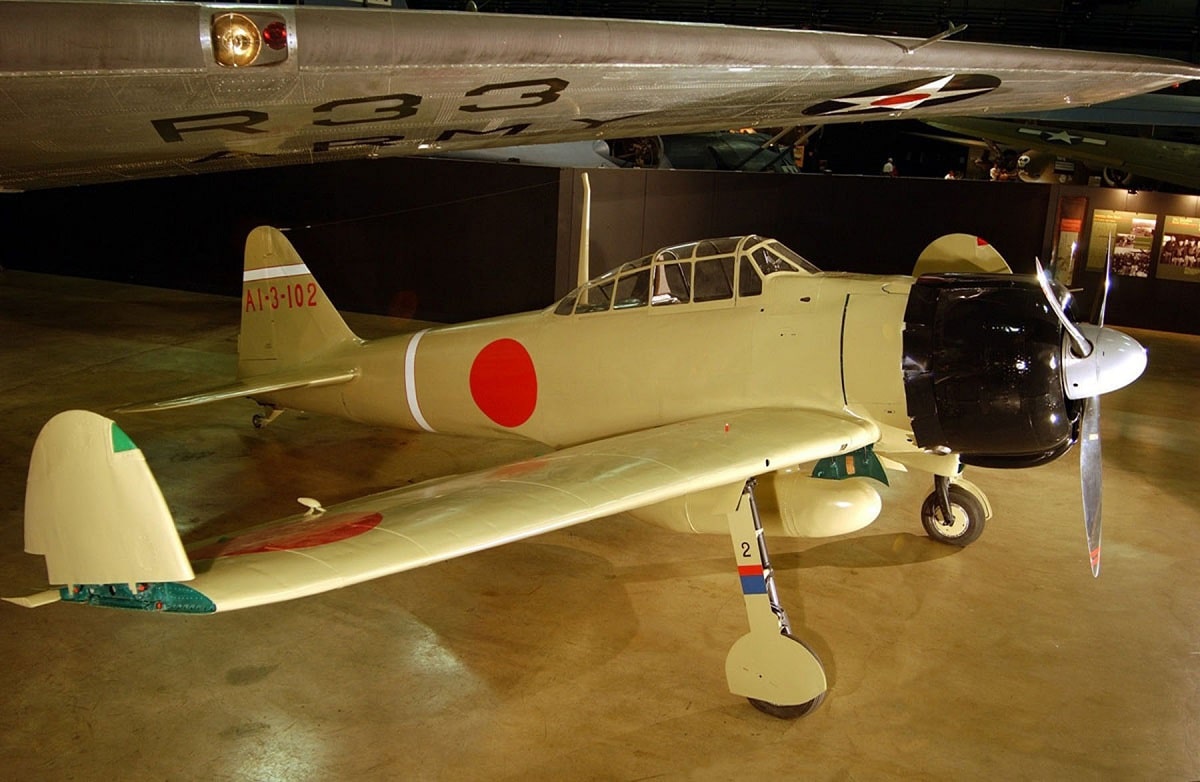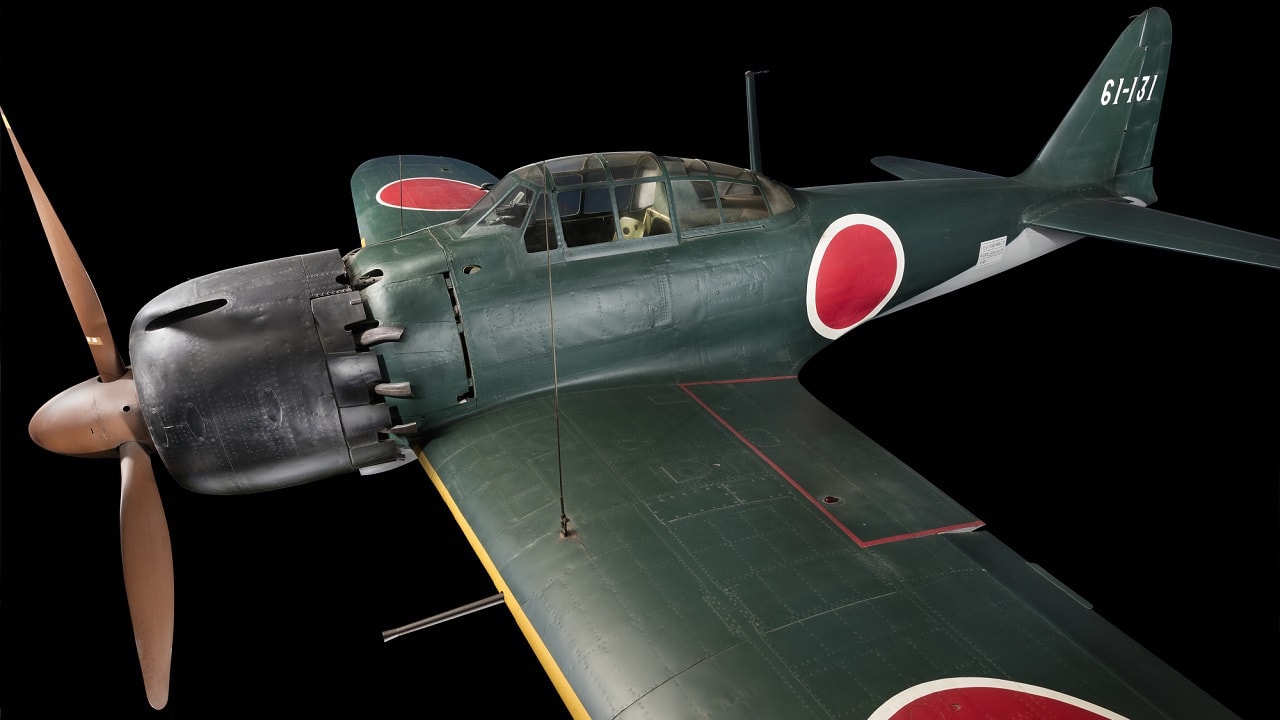Back in the day, Imperial Japan had quite a fierce war machine, and this was especially true of its warplanes.
With that in mind, let’s take a look at the Top 5 fighter aircraft ever made by that East Asian island nation, clearly focusing on World War II.
Mitsubishi A6M “Zero/Zeke”
Might as well start off with the most famous and iconic of the bunch right off the bat, right?
This plane made its maiden flight on April Fool’s Day 1939 and entered into operational service with the Imperial Japanese Navy (IJN) Air Service in July of the following year. At the outset of WWII, this was undoubtedly the deadliest fighter of the Pacific Theater, with speed – maxing out at 331 miles per hour – and maneuverability unmatched by any of the early Allied fighter planes. Armament was formidable too, consisting of two 7.7 mm Type 97 machine guns in the engine cowling, and two 20 mm Type 99-1 Mk 3 cannon in the wings.
These factors resulted in an initial 12:1 air-to-air kill ratio in favor of the Zero, and it was flown by Japan’s best-known (to Westerners anyway) fighter pilot, Saburo Sakai, who was Japan’s third-ranking air ace.
However, it was highly vulnerable due to its lack of armor and self-sealing fuel tanks, which made the plane light up like a tinderbox when hit by a solid burst of gunfire.
Out of 10,939 Zeroes built, roughly 30 survive today; the lone airworthy A6M5 “Zeke” is with the Planes of Fame Air Museum in Chino, California.

DAYTON, Ohio — Mitsubishi A62M Zero at the National Museum of the United States Air Force. (U.S. Air Force photo)
Nakajima Ki-43 Hayabusa (隼; “Peregrine Falcon”) (Allied reporting name “Oscar”)
This plane was ofttimes for a Zero because of the two warbirds’ highly similar appearance. However, the Zero was strictly an IJN warbird, whilst the “Oscar” belonged to the Imperial Japanese Army Air Force (JAAF). Making its maiden flight in January 1939 and being officially introduced into JAAF service in October 1941, the Ki-43 was well-liked by its pilots for its excellent maneuverability and leisurely flying characteristics. Nearly all of the JAAF’s aces nabbed at least some of their kills in the Hayabusa; then-Sgt. (later Lt. Col.) Satoru Anabuki was the top dog amongst them, with 39 kills. Max airspeed was 330 mph, with armament consisting of two 7.7mm machine guns in the first variant and two 20mm cannon in the final variant
However, the Oscar had the same vulnerabilities as the Zero. What’s more, it has the dubious distinction of being the only fighter plane ever shot down with a pistol, by a parachutist no less!
There are five bona fide (i.e. not counting reproductions) surviving Oscars today out of the 5,919 built.
Nakajima Ki-84 Hayate (キ84 疾風; “Gale” or “Hurricane”) (Allied reporting name “Frank”)
“Forget it, it’s a Frank.” These were the resigned, melancholy words uttered by USAAF radar operators when spotting the next plane on our list. Against any other Japanese fighter, they would dispatch P-51D Mustang fighters, but not so with the Ki-84 Hayate, which made its maiden flight in February 1943 and went operational in June 1944. As noted by the Aviation Online History Museum, “It outperformed the F6F Hellcat, P-51 Mustang and P-47 Thunderbolt,” very impressive considering just how deadly those three American fighters were! (Though a comparison to the P-38 Lightning is conspicuous by its absence from the article.)
The “Frank” was the fastest single-engine fighter flown by the JAAF in WWII, with a max airspeed of 387 mph during level flight and 496 mph in a dive. Built as one of Japan’s last best hopes against the B-29 Superfortress raids, this plane was armed with two 12.7 mm machine guns above the cowling and two 20 mm cannons located in the wings. However, with only 3,382 built, it was too little, too late against the sheer industrial might of America’s airplane manufacturing capacity.
There’s only one surviving “Frank” left today, housed at the Chiran Peace Museum (知覧特攻平和会館, Chiran Tokkō-Heiwa-Kaikan) in Japan’s Kagoshima Prefecture. Tamiya produced a high-quality 1:48 scale plastic model kit of the plane.
Kawasaki Ki-61 Hien (飛燕,; “Flying Swallow”) (Allied reporting name “Tony”)
As far as I know, this was Imperial Japan’s only fighter plane which shared a nickname with a fighter plane belonging to that nation’s Nazi German Luftwaffe allies, the Messerschmitt Me 262 Schwalbe (“Swallow”). Of course, a major difference between the two Swallows was that the German one was a jet fighter whilst Japan’s was still a piston-engine prop job. However, the Hien was still a pretty darn good prop job. For example, the JAAF’s 244th Sentai fighter unit used the fighter to destroy 73 B-29s; chief among this unit’s aces was Captain Nagao Shirai, who downed 11 B-29s in addition to two Hellcats.
Making its maiden flight in December 1941 and entering operational service the following year, its was so radically different in appearance from other Japanese fighters that Allied intelligence types initially (and mistakenly) assumed that the plane license-built an Italian Macchi C.202 Folgore (“Thunderbolt”), thusly serving as the inspiration for the Ki-61’s Western nickname of “Tony.” Japan’s “Tony” had a top speed of 360 mph and was armed with two fuselage-mounted 20mm cannon and two wing-mounted 12.7mm machine guns.
Four “Flying Swallows” survive today, in varying degrees of restoration.
Kawasaki Ki-100 (キ100; no Japanese nickname Allied reporting name)
In the 1958 book “Fighter Planes That Made History,” author David Coxe Cooke claimed that a squadron of Ki-100s shot down an **entire squadron of 14 Hellcats with no losses incurred in return**! Though the veracity of this claim is much in doubt, what’s not in doubt is that the Ki-100 was a top-notch fighter plane, roughly equal and perhaps even slightly superior to the Hellcat and the Mustang. Luckily for the Allies, only 396 of these planes were built, with one surviving today, at the RAF Museum London.
Armament mirrored that of the “Tony’s,” and max airspeed was 360 mph.
Christian D. Orr is a former Air Force Security Forces officer, Federal law enforcement officer, and private military contractor (with assignments worked in Iraq, the United Arab Emirates, Kosovo, Japan, Germany, and the Pentagon). Chris holds a B.A. in International Relations from the University of Southern California (USC) and an M.A. in Intelligence Studies (concentration in Terrorism Studies) from American Military University (AMU). He has also been published in The Daily Torch and The Journal of Intelligence and Cyber Security. Last but not least, he is a Companion of the Order of the Naval Order of the United States (NOUS).
From the Vault

